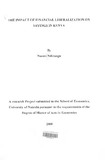| dc.description.abstract | Since the onset of the financial liberalization hypothesis, Kenya has implemented far
reaching reforms. However, the experience of Kenya with financial liberalization has
been predominantly traumatic, and whether financial liberalization impacts positively on
savings, remains purely an empirical issue. This paper presents an analysis of effects of
financial liberalization on savings in Kenya during the period 1971 to 2004. To see this
effect, this study specified and estimated a long-run real savings model with measures of
financial intermediation as its variates.
The overall assessment of the financial liberalization is positive. The economic results
reveal that there is a long-run relationship between real savings and measures of financial
intermediation, proxied by domestic credit to GDP ratio and financial deepening
measured by (M2/GDP). Real deposits rate has positive impact on private saving rates.
After analyzing the various channels through which such an impact can take place, we
conclude that the overall net effect is ambiguous. On one hand the result suggests a
positive and significant association between private saving and financial intermediation.
The estimated coefficient is significant, suggesting that higher credit availability does not
reduce private saving. On the other hand the results suggest a negative association
between private savings and financial deepening. The estimated coefficient is significance and negative, indicating disavings by private sector as financial assets
mcreases.
In general the result illustrates that financial liberalization, combined with adequate
prudential regulation and strong supervision of banking can breed a sound and deep
financial. system able to boost savings over an extended period. It also suggests that larger
benefits can be reaped when financial reform does not come as an isolated policy action,
but is part of a consistent and comprehensive strategy of stabilization and structural
reform in the financial sector.
The ambiguity in these results perhaps suggest that liberalization process was introduced
in a hurry when the financial sector was in crisis and without proper macroeconomic
stability. The study recommends that maintenance of a stable financial system is
important for the achievement of positive results from the liberalization process. Policy
approaches should be geared towards strengthening the legal infrastructure, in order to
lower costs and risks associated with non-performing loans, addressing the high
intermediation margins. This will make banks attractive to savers hence increasing
financial savings. | en |

